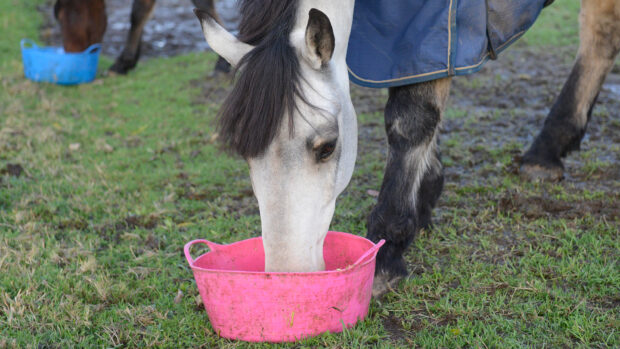After learning a little about what feed balancers are, you might be wondering how they differ from vitamin and mineral supplements. After all, vitamin and mineral supplements often come in a plastic tub, and you don’t need more than a tablespoon or two per day, so on the surface, they seem more efficient and cost effective. And don’t they both add vitamins and minerals to the horse’s diet? They do, but balancers do more than that.
Clare Barfoot, RNutr, the marketing, research, and development director at Spillers, tells us: “A balancer, in addition to appropriate amounts of forage, can be used as the complete bucket feed. Whereas a supplement usually comes in liquid or powdered form and is added to the existing bucket feed to supply a broad spectrum of vitamins and minerals that may be otherwise lacking. Balancers also provide a source of good quality protein with essential amino acids to help meet daily requirements. They often contain other functional ingredients such as digestive, hoof, joint and immune support, which aren’t usually included in more general vitamin and mineral supplements.”
Katie Grimwood, BSc (Hons), the nutrition advisor for Bailey’s, adds: “Powdered broad-spectrum supplements are generally fed at much lower levels, of between 30-100g per day, depending on the size of the horse and their level of work, and so at first glance they may seem more appealing when feeding horses prone to gaining too much weight. However, it is important to remember that pelleted balancers can be fed alone as the sole concentrate, whereas powdered supplements will generally need to be fed along with a ‘carrier’, such as chaff or sugar beet, which will in turn supply their own contribution of calories/energy into the diet.”
In other words, balancers look like other pelleted feeds and can be fed in place of other types of hard feeds. Kate Hore, RNutr (Animal), the registered nutritionist with NAF, observed that horse owners can feed vitamin supplements and probiotic yeast supplements for more or less the same purpose.
“In many ways they are very similar, as both provide a concentrated source of the essential micronutrients to balance the diet. Often the choice will come down to personal preference, for both horse and rider,” she explains.
Since balancers are a complete feed and not a powder, they do not need a ‘carrier,’ as Grimwood explained, such as chaff or sugar beet or any cube or mix.
“[They] in turn supply their own contribution of calories/energy into the diet.”
That means balancers could be a good choice for owners who are concerned about their horses getting fat or fizzy on any sort of hard feed, but who still want to add vitamins and minerals.
However, balancers provide horses with proteins and amino acids, which may not be found in powdered vitamin supplements.
Grimwood stresses: “These are the building blocks of all body tissues, including horn, hair, muscle and bone, so are pretty important and are often deficient in modern forages. This extra good quality protein generally comes from ingredients such as alfalfa and micronised soya beans, which are included in pelleted balancers.
Soya in particular has a great amino acid profile, being high in the essential amino acid, lysine. With the right dietary components, the horse’s body can manufacture most amino acids but there are a small number of “essential” ones, like methionine and lysine, which have to be included in the horse’s diet.”
Many cube and mix feeds also provide these important proteins and amino acids, and owners can ‘top up’ those feeds with a balancer or a vitamin/mineral supplement, but the balancers are a good option for owners who don’t want their horses on much of a hard feed.
You might also be interested in:

Feed balancers: what’s on the market?

How to choose the right feed balancer for your horse

Subscribe to Horse & Hound magazine today – and enjoy unlimited website access all year round
Horse & Hound magazine, out every Thursday, is packed with all the latest news and reports, as well as interviews, specials, nostalgia, vet and training advice. Find how you can enjoy the magazine delivered to your door every week, plus options to upgrade your subscription to access our online service that brings you breaking news and reports as well as other benefits.




